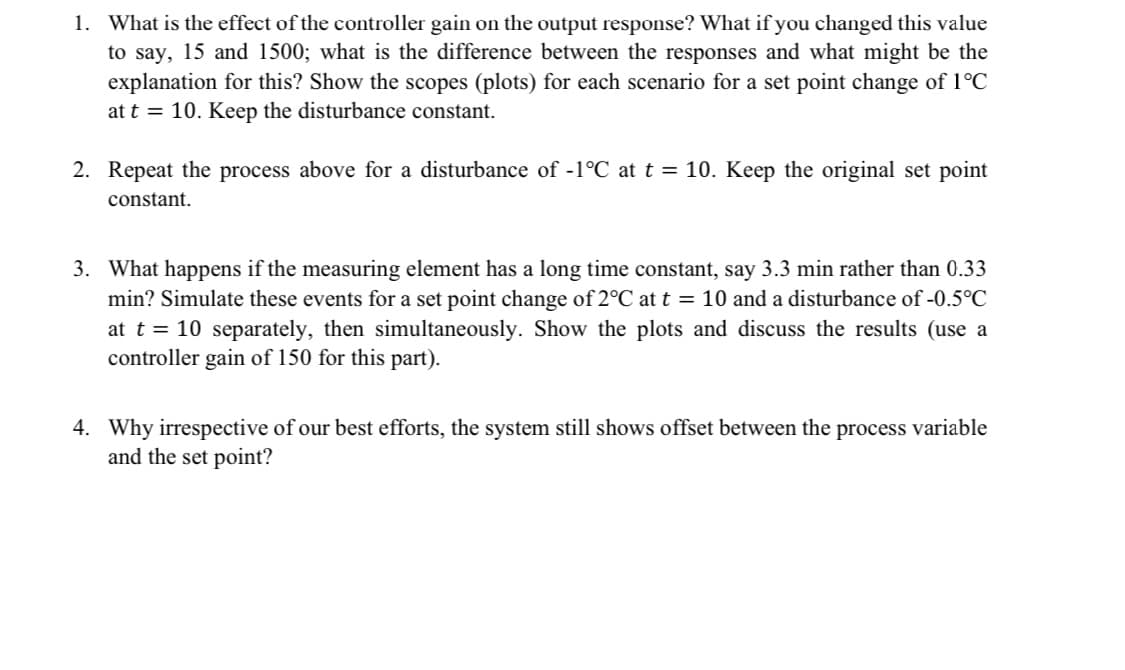1. What is the effect of the controller gain on the output response? What if you changed this value to say, 15 and 1500; what is the difference between the responses and what might be the explanation for this? Show the scopes (plots) for each scenario for a set point change of 1°C at t = 10. Keep the disturbance constant. 2. Repeat the process above for a disturbance of -1°C at t = 10. Keep the original set point constant. 3. What happens if the measuring element has a long time constant, say 3.3 min rather than 0.33 min? Simulate these events for a set point change of 2°C at t = 10 and a disturbance of -0.5°C at t = 10 separately, then simultaneously. Show the plots and discuss the results (use a controller gain of 150 for this part). 4. Why irrespective of our best efforts, the system still shows offset between the process variable and the set point?
1. What is the effect of the controller gain on the output response? What if you changed this value to say, 15 and 1500; what is the difference between the responses and what might be the explanation for this? Show the scopes (plots) for each scenario for a set point change of 1°C at t = 10. Keep the disturbance constant. 2. Repeat the process above for a disturbance of -1°C at t = 10. Keep the original set point constant. 3. What happens if the measuring element has a long time constant, say 3.3 min rather than 0.33 min? Simulate these events for a set point change of 2°C at t = 10 and a disturbance of -0.5°C at t = 10 separately, then simultaneously. Show the plots and discuss the results (use a controller gain of 150 for this part). 4. Why irrespective of our best efforts, the system still shows offset between the process variable and the set point?
Introduction to Chemical Engineering Thermodynamics
8th Edition
ISBN:9781259696527
Author:J.M. Smith Termodinamica en ingenieria quimica, Hendrick C Van Ness, Michael Abbott, Mark Swihart
Publisher:J.M. Smith Termodinamica en ingenieria quimica, Hendrick C Van Ness, Michael Abbott, Mark Swihart
Chapter1: Introduction
Section: Chapter Questions
Problem 1.1P
Related questions
Question
Do the simulation and answer this

Transcribed Image Text:1. What is the effect of the controller gain on the output response? What if you changed this value
to say, 15 and 1500; what is the difference between the responses and what might be the
explanation for this? Show the scopes (plots) for each scenario for a set point change of 1°C
at t = 10. Keep the disturbance constant.
2. Repeat the process above for a disturbance of -1°C at t = 10. Keep the original set point
constant.
3. What happens if the measuring element has a long time constant, say 3.3 min rather than 0.33
min? Simulate these events for a set point change of 2°C at t = 10 and a disturbance of -0.5°C
at t = 10 separately, then simultaneously. Show the plots and discuss the results (use a
controller gain of 150 for this part).
4. Why irrespective of our best efforts, the system still shows offset between the process variable
and the set point?
Expert Solution
This question has been solved!
Explore an expertly crafted, step-by-step solution for a thorough understanding of key concepts.
This is a popular solution!
Trending now
This is a popular solution!
Step by step
Solved in 2 steps

Recommended textbooks for you

Introduction to Chemical Engineering Thermodynami…
Chemical Engineering
ISBN:
9781259696527
Author:
J.M. Smith Termodinamica en ingenieria quimica, Hendrick C Van Ness, Michael Abbott, Mark Swihart
Publisher:
McGraw-Hill Education

Elementary Principles of Chemical Processes, Bind…
Chemical Engineering
ISBN:
9781118431221
Author:
Richard M. Felder, Ronald W. Rousseau, Lisa G. Bullard
Publisher:
WILEY

Elements of Chemical Reaction Engineering (5th Ed…
Chemical Engineering
ISBN:
9780133887518
Author:
H. Scott Fogler
Publisher:
Prentice Hall

Introduction to Chemical Engineering Thermodynami…
Chemical Engineering
ISBN:
9781259696527
Author:
J.M. Smith Termodinamica en ingenieria quimica, Hendrick C Van Ness, Michael Abbott, Mark Swihart
Publisher:
McGraw-Hill Education

Elementary Principles of Chemical Processes, Bind…
Chemical Engineering
ISBN:
9781118431221
Author:
Richard M. Felder, Ronald W. Rousseau, Lisa G. Bullard
Publisher:
WILEY

Elements of Chemical Reaction Engineering (5th Ed…
Chemical Engineering
ISBN:
9780133887518
Author:
H. Scott Fogler
Publisher:
Prentice Hall


Industrial Plastics: Theory and Applications
Chemical Engineering
ISBN:
9781285061238
Author:
Lokensgard, Erik
Publisher:
Delmar Cengage Learning

Unit Operations of Chemical Engineering
Chemical Engineering
ISBN:
9780072848236
Author:
Warren McCabe, Julian C. Smith, Peter Harriott
Publisher:
McGraw-Hill Companies, The